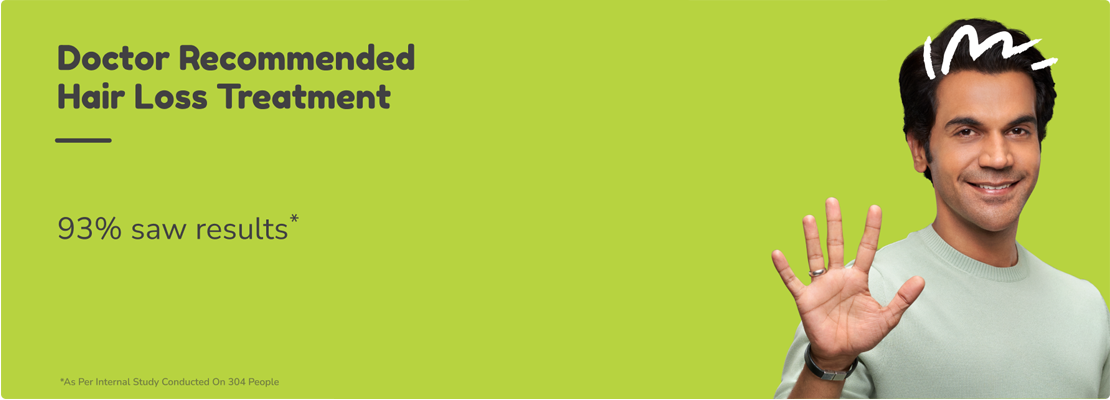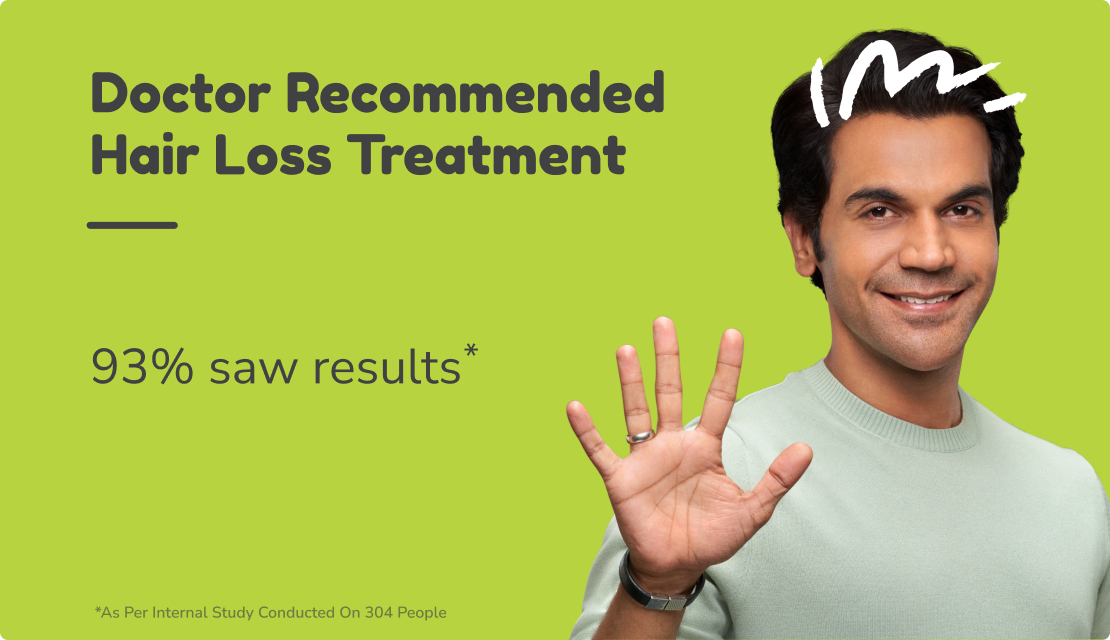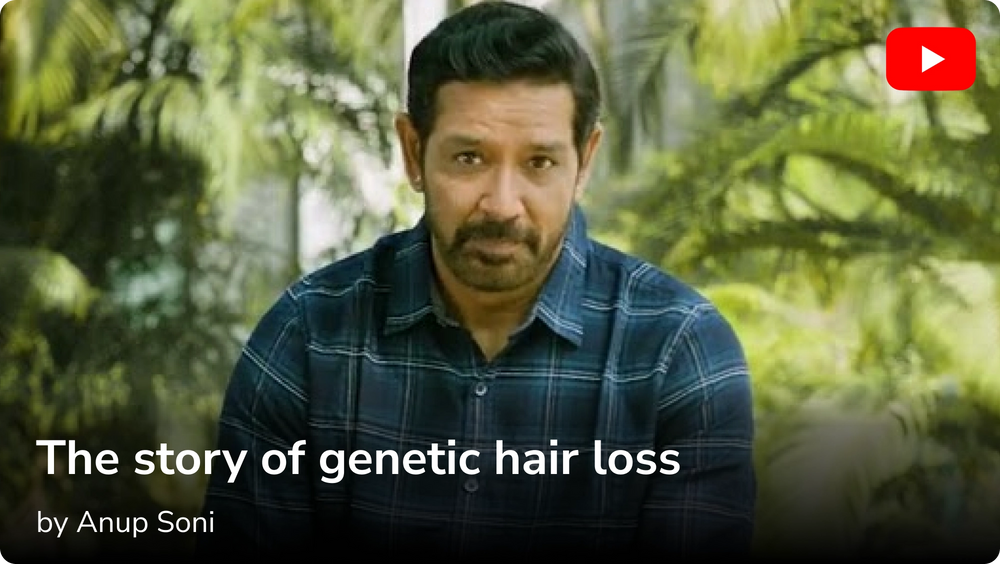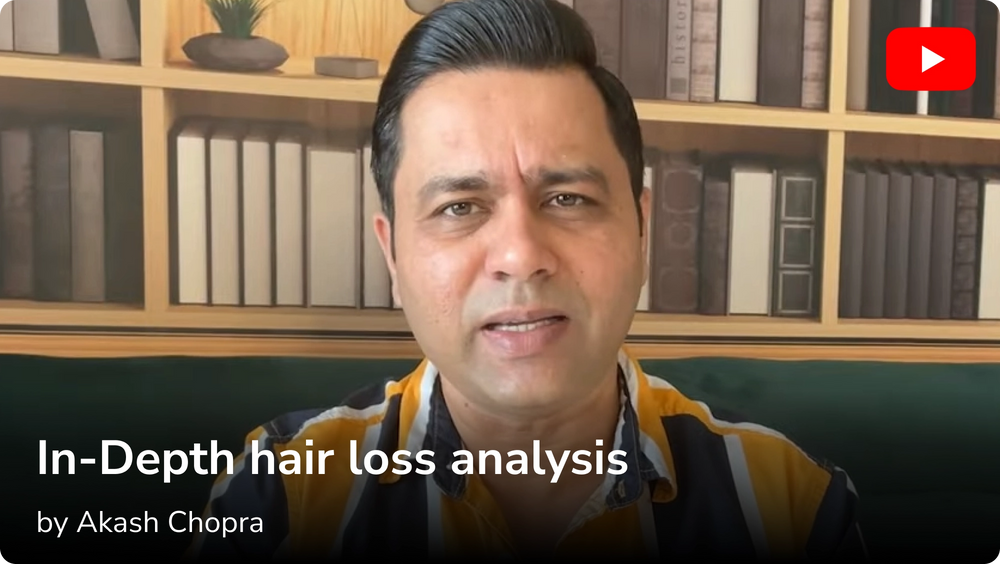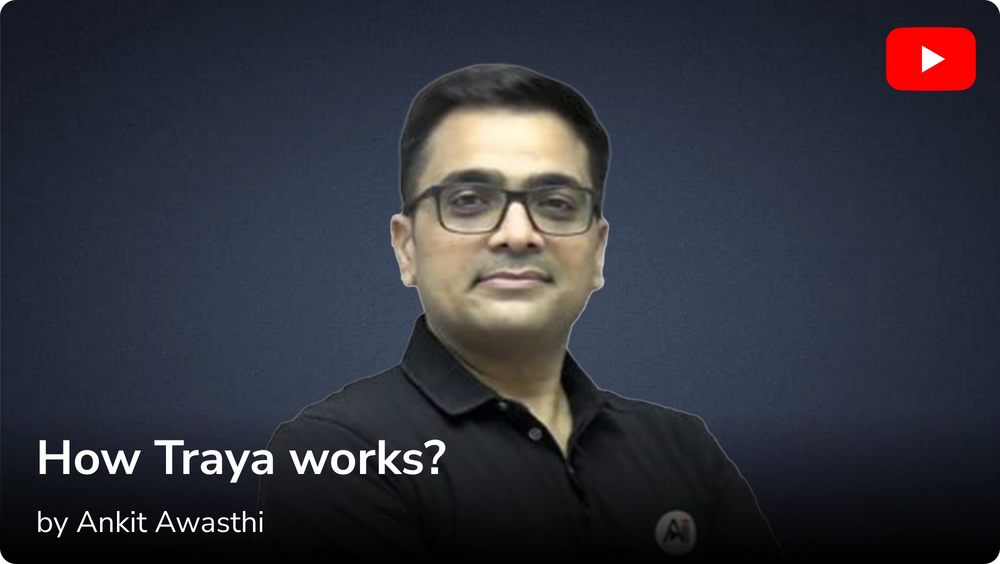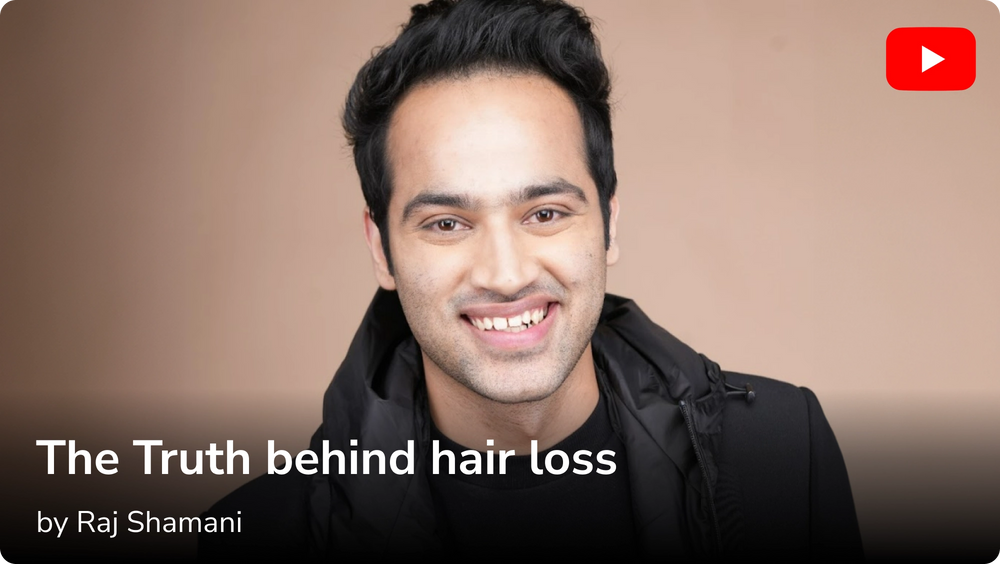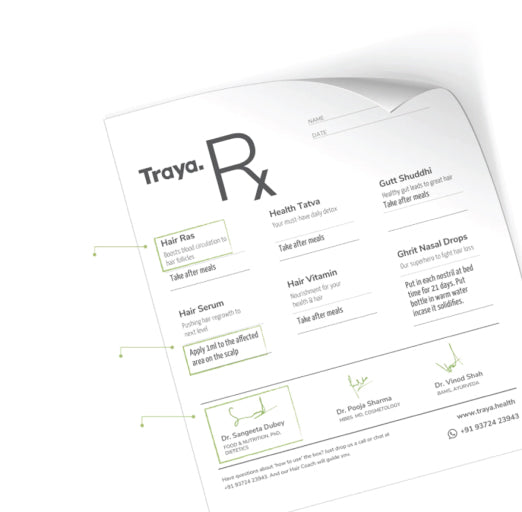Are you so tired of trying out products and remedies that all you want now is a QUICK FIX? We have seen over 8,00,000+ people at a stage where nothing seemed to work, and the hair fall only worsened. But little changes in your habits can take you very far, and we will tell you what they are!
The answer to “How to stop hair loss and regrow hair naturally” isn’t simple because well, regrowing hair in 3 weeks sounds ambitious. However, one can surely see a difference with the correct steps and consistency. It's all about knowing your hair and fulfilling its proper nourishment and growth needs.
You have probably already tried shampoo, oils, hair care routines and home remedies. Some might have worked a little, but nothing will completely solve your problem and regrow your hair. Do you know why? Because hair fall is personal. Everyone has different hair and a different lifestyle, so to know more about what kind of nourishment and treatment will be beneficial, it is essential to analyze the root cause of the problem.
Get to Know about the cause of your hair loss this hair test will help you with ways to address it directly. Root cause simply means the specific causes behind your hair fall. Stress, poor gut health, hormonal imbalances, dandruff, genetic factors, environment and lifestyle are a few root causes behind your hair being weak and falling. To find out what is causing your hair loss, all you have to do is look within and give Traya’s Free Online Hair Test.
Take Traya's Free Hair Test Today!!
How to Regrow Hair Naturally in 3 weeks - Natural Remedies that Help
It is easy to know how to stop hair fall naturally and regrow hair naturally in 3 weeks and see substantial results by incorporating simple practices like taking care of your hair hygiene and oil frequently and having nutritious meals that ensure your deficiencies are addressed. Simple activities like exercising regularly and avoiding unhealthy food can go a long way. Moreover, stress management techniques and practising mindfulness also help.
Scalp Massage:
Massaging your scalp regularly for about 15 minutes daily boosts the blood flow to your head. This nourishes your hair follicles and encourages healthy hair growth. So, if you want your hair to look and feel better, try adding a simple scalp massage to your daily routine. It's an easy way to care for your hair and make it healthier.
Also Read: How to use Derma Roller for Hair Growth
Essential Oils
Here are some oils that can boost hair growth:
Known for its invigorating properties, peppermint oil can promote hair growth. It stimulates blood circulation when mixed with carrier oil, such as coconut or jojoba oil, and applied to the scalp bi-weekly.
Customer Testimonials:-

Black seed oil is recognised for its richness in nourishing compounds, including vitamins, minerals, and antioxidants. When used as a home remedies for hair growth and thickness, it supports healthy hair growth by providing essential nutrients to the hair follicles.
Marula oil is excellent for addressing scalp conditions and repairing damaged follicles. Rich in antioxidants and omega fatty acids, it moisturizes the scalp and helps maintain a healthy balance.
Also Read : Best Hair Growth Oils Recommended by Doctor
Aloe Vera Gel
Aloe vera has the potential to foster hair growth, particularly when the cause of hair loss is an inflammatory condition on the scalp. However, it is more probable that aloe vera contributes to overall hair health by providing essential conditioning and moisturization to both the hair and scalp. After cleansing the scalp and conditioning the hair with aloe vera, individuals may observe a reduction in hair breakage and loss. While some claim that aloe vera accelerates hair growth, there is limited clinical evidence to substantiate or refute such assertions. It's essential to recognize the beneficial impact of aloe vera in maintaining healthy hair, even though the extent of its influence on rapid hair growth remains inconclusive.
Customer Testimonials:-

Coconut Milk
Naturally rich in fatty acids, coconut milk possesses exceptional moisturizing properties, leaving your hair soft and tangle-free. Packed with vitamins, proteins, zinc, and iron, coconut milk goes beyond surface benefits, working to maintain the overall health of your hair and scalp while promoting growth. Its nourishing qualities contribute to strengthened hair, growth stimulation, and combatting dandruff, making it an excellent choice for restoring dry hair.
Egg Mask
Using an egg hair mask is like giving your hair a boost of essential nutrients that help it grow longer. The biotin in egg yolks is great for improving hair elasticity, making your hair more flexible. The protein and biotin in eggs also support hair growth. Using an egg mask once or twice a month can help your hair regrow and become healthier and more elastic.
Customer Testimonials:-

Green Tea Rinse
Applying green tea topically offers potential benefits for your scalp and hair growth.
Also Read: Redensyl vs Minoxidil - Which one is better?
Dietary Supplements:
Here are some supplements you must consume to boost hair growth:
- Vitamin B12
- Increases oxygen to hair follicles, stimulating and replacing lost strands.
- Provides a thicker appearance to the hair.
- Biotin (Vitamin B7)
- Stimulates keratin production, promoting follicle growth.
- Found in various foods such as eggs, meat, fish, nuts, sweet potatoes, and seeds.
- Vitamin D
- Deficiencies can lead to conditions like alopecia, female pattern hair loss, and excessive shedding.
- Food sources include fatty fish, cod liver oil, fortified foods (cereal, eggs, bread, yoghurt), mushrooms, or exposure to sunlight (sunbathing).
Take Traya's Free Hair Test Today!!
- Vitamin E
- Possesses antioxidant properties, curbing oxidative stress and balancing free radicals.
- Effective in treating hair loss, found in sunflower seeds, spinach, avocados, and almonds.
- Supplements should be taken as advised by a doctor.
- Iron
- Essential for hemoglobin production, distributing oxygen for cell repair and growth.
- Deficiency can lead to hair loss, with sources including eggs, red meat, lentils, spinach, oysters, and clams.
- Intake recommended based on doctor's advice.
- Zinc
- Promotes hair growth and maintains oil glands around follicles.
- Deficiency can result in hair loss, especially in excessive alcohol drinkers, pregnant or breastfeeding women, and those with chronic kidney ailments.
- Should be taken as prescribed by a doctor.
- Magnesium
- Aids in maintaining blood flow, supplying necessary oxygen for hair growth.
- Prevents calcium deposition in follicles.
- Calcium
- Stimulates hair growth by secreting the hormone Androgen.
- Facilitates nutrient transport supporting hair growth.
- Found in foods like tofu, broccoli, dairy products, beans, and almonds.
- Supplements to be taken as recommended by a healthcare professional.
What Causes Hair Loss?
Genetic Factors:
Hereditary conditions are a primary cause of hair loss in men and women. Various genes, including mutations in the androgen receptor (AR) gene, are implicated in Androgenetic Alopecia. This condition, commonly known as Male Pattern Baldness (MPB) or Female Pattern Baldness (FPB), follows a predictable pattern. In men, MPB typically initiates with an m-shaped recession at the front of the scalp and frequently commences in the 20s or 30s. Approximately 80 per cent of men experience MPB by the age of 80.
Hormonal Imbalances:
Approximately 50% of individuals dealing with hyperthyroidism and 33% facing hypothyroidism experience diffuse telogen hair loss. The imbalances in these hormones significantly influence the hair cycle and follicle structure. Among these hormonal factors, androgens, including testosterone (T), dihydrotestosterone (DHT), and their prohormones like dehydroepiandrosterone sulfate (DHEAS) and androstenedione (A), are key contributors to terminal hair growth. Changes in hormones, especially during menopause or postpartum, can lead to hair thinning.

Medical Treatments:
Certain medications, like vitamin A and antibiotics, antidepressants, mood stabilizers, weight loss drugs, gout medications, and chemotherapy, have been identified to induce temporary hair loss. Conversely, some treatments, such as hormone therapy, may lead to permanent hair loss. Some medications can also cause hair loss as a side effect.
Also Read: Best Serum for Hair Growth and Thickness in India
Stress
Telogen effluvium is a condition triggered by significant stress, In this condition a considerable number of hair follicles are compelled into a resting phase,This can be caused by pregnancy, surgery, childbirth, and serious illness. As time goes by, individuals may experience the shedding of affected hairs abruptly during routine activities such as combing or washing.
Hairstyling Practices
Hairstyles that consistently exert tension on the hair, such as tightly pulled buns, ponytails, and up-dos, contribute to this issue. Using heated styling tools, like hair dryers and straighteners operating at damaging temperatures, can cause harm to the hair shaft, leading to breakage and frizz. Specifically, tightly tied hairstyles have been associated with a condition known as Traction Alopecia.
Conclusion
Regrowing hair naturally within a short timeframe requires Time and Consistency. By addressing underlying causes and nurturing hair follicles, incorporating practices like scalp massages, essential oils, and dietary supplements can lead to noticeable improvements in hair health and growth.
It is easy to find out the root cause of your hair fall and start working on it. Traya finds the root cause of your hair loss through a hair test and recommends a personalized kit made for YOU. In the first month, we directly address the root causes of your hair loss, which will start showing improvements in the first 3 weeks.
While expecting full regrowth within three weeks may vary for individuals, consistent application of these natural remedies offers a promising path toward revitalizing hair. For those wondering about the possibility of regrowing lost hair naturally, the key lies in a dedicated and multifaceted effort to support overall hair well-being.
- Embarking on a journey to regrow hair naturally is challenging but achievable with the right approach.
- Hair loss can result from genetic factors, hormonal imbalances, medical treatments, stress, and hairstyling practices. You can find out the cause by giving Traya’s free online hair test.
Take Traya's Free Hair Test Today!!
- Understanding the hair growth cycle, including the anagen, catagen, and telogen phases, is crucial in addressing hair loss.
- Natural remedies for regrowing hair in three weeks include scalp massages, essential oils like peppermint and black seed oil, marula oil, and onion juice.
- Dietary supplements containing Vitamin B12, calcium, magnesium, zinc, and iron can support hair health when dietary intake is insufficient.
People Also Ask (Frequency Asked Questions)
Q. Is it possible for hair to regrow within three weeks?
Yes, With the right treatment and nourishment according to your hair type it is possible to regrow hair in 3 weeks. For this to happen you must know the root cause of your problem and treat it in the way it's required. This may not be in the case of baldness but the sooner the problem is addressed better the results.
Q. How can I speed up hair growth effectively?
To boost hair growth effectively, maintain a nutrient-rich diet, indulge in regular scalp massages, and trim your hair regularly to prevent split ends. Use gentle hair care products, stay hydrated, and consider incorporating essential oils or supplements known for promoting healthy hair. Consistent practice of these habits can contribute to faster and healthier hair growth.
Q. What natural methods can accelerate hair growth in three weeks?
Promote faster hair growth naturally in three weeks by doing scalp massages, using essential oils like peppermint, maintaining a nutrient-rich diet, staying hydrated, and practicing gentle hair care. While individual results may vary, these methods can contribute to healthier hair within a short timeframe.
Q. Is natural regrowth possible for lost hair?
If your hair follicles are okay, it usually takes a few months to see real changes. But if your follicles are closed or the problem sticks around, it's best to see a hair specialist since natural methods might not do the trick. Massaging your scalp regularly and using certain products might help your hair grow naturally. Talking to a specialist is a good idea for personalized advice on how to deal with your hair concerns.
REFERENCES
Dmitri Wall, Nekma Meah, Nicole Fagan, Katherine York, and Rodney Sinclair| JANUARY 2022 | Advances in hair growth |
https://www.ncbi.nlm.nih.gov/pmc/articles/PMC8808739/
Ji Young Oh Min Ah Park, and Young Chul Kim | DECEMBER 2014 |
Peppermint Oil Promotes Hair Growth without Toxic Signs |
https://www.ncbi.nlm.nih.gov/pmc/articles/PMC4289931/
By Kristeen Moore and Rachel Nall | Updated on NOVEMBER 2022 | Everything You Need to Know About Hair Loss |
https://www.healthline.com/health/hair-loss



